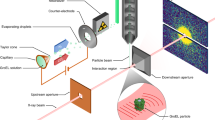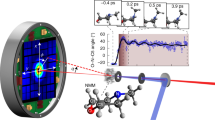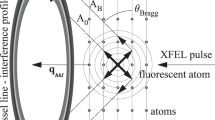Abstract
The extension of time-resolved X-ray diffraction to the subpicosecond domain is an important challenge, as the nature of chemical reactions and phase transitions is determined by atomic motions on these timescales. An ultimate goal is to study the structure of transient states with a time resolution shorter than the typical period of vibration along a reaction coordinate (around 100 fs). Biological processes that can be initiated optically have been studied extensively by ultrafast infrared, visible and ultraviolet spectroscopy1. But these techniques probe only electronic states, whereas time-resolved crystallography should be able to directly monitor atomic positions. Here we show that changes in the X-ray diffraction pattern from an organic film heated by a laser pulse can be monitored on a timescale of less than a picosecond. We have studied the response of a Langmuir–Blodgett multilayer film of cadmium arachidate to laser heating by observing changes in the intensity of one Bragg peak for different delays between the perturbing optical pulse and the X-ray probe pulse. A strong decrease in intensity is seen within a picosecond of heating, resulting from disorder introduced to the layers of cadmium atoms before thermal expansion of the film (which ultimately leads to its destruction) has time to occur.
This is a preview of subscription content, access via your institution
Access options
Subscribe to this journal
Receive 51 print issues and online access
$199.00 per year
only $3.90 per issue
Buy this article
- Purchase on Springer Link
- Instant access to full article PDF
Prices may be subject to local taxes which are calculated during checkout



Similar content being viewed by others
References
Vos, M. H. & Martin, J.-L. Femtosecond biology. Annu. Rev. Biophys. Biomol. Struct. 21, 199–222 (1992).
Larsson, J. et al. Time-resolved X-ray diffraction from laser-excited crystals.in Application of High Field & Short Wavelength Soources (Plenum, New York, in the press).
Schoenlein, R. W. et al. Femtosecond X-ray pulses at 0.4 Å generated by 90° Thomson scattering: a tool for probing the structural dynamics of materials. Science 274, 236–238 (1996).
Rousse, A. et al. Efficient KαX-ray source from femtosecond laser-produced plasmas. Phys. Rev. E 50, 2200–2207 (1994).
Murname, M. M., Kapteyn, H. C., Rosen, M. D. & Falcone, R. W. Ultrafast X-ray pulses from laser-produced plasmas. Science 251, 531–536 (1991).
Kieffer J. C. et al. Ultrafast X-ray sources. Phys. Fluids B 5, 2676–2681 (1993).
Geindre, J. P. et al. X-rays generated by femtosecond laser-produced plasmas.in Ultrafast Phenomena VIII (Springer, Berlin, (1993)).
Chukhovskii, F. N. & Förster, E. Time-dependent X-ray Bragg diffraction. Acta Crystallogr. A51, 668–672 (1995).
Larson, B. C., White, C. W., Noggle, T. S., Barhorst, J. F. & Mills, D. M. Time-resolved X-ray diffraction measurement of the temperature and temperature gradients in silicon during pulsed laser annealing. Appl. Phys. Lett. 42, 282–284 (1983).
Chen, P., Tomov, V. & Rentzepis, P. M. Time resolved heat propagation in a gold crystal by means of picosecond X-ray diffraction. J. Chem. Phys. 104, 10001–10007 (1996).
Rose-Petruck, C. et al. Measurements of ultrafast dynamics in GaAs crystals using time-resolved X-ray diffraction.in Application of High Field & Short Wavelength Soources (Plenum, New York, in the press).
Compton, A. H. & Allison, S. K. X-rays in Theory and Experiment.(van Nostrand, Princeton, New Jersey, (1954)).
Stuart, B. C. et al. Nanosecond-to-femtosecond laser-induced breakdown in dielectrics. Phys. Rev. B53, 1749–1761 (1996).
Ammosov, M. V., Delone, N. B. & Krainov, V. P. Tunnel ionization of complex atoms and of atomic ions in an alternating electromagnetic field. Sov. Phys. JETP 64, 1191–1194 (1986).
Ráksi, F. et al. Ultrafast X-ray absorption probing of a chemical reaction. J. Chem. Phys. 104, 6066–6069 (1996).
Bastiani, S. et al. Experimental study of the interaction to subpicosecond laser pulses with solid targets of varying initial scale lengths. Phys. Rev. E (in the press).
Acknowledgements
We gratefully acknowledge the support of the laser staff at Laboratoire d'Optique Appliquée where the experiments were carried our. C.R. was supported by a grant from the Carlsberg Foundation. This work was supported by the Centre National de la Recherche Scientifique and by the European Community under the Large Facility Program.
Author information
Authors and Affiliations
Corresponding author
Rights and permissions
About this article
Cite this article
Rischel, C., Rousse, A., Uschmann, I. et al. Femtosecond time-resolved X-ray diffraction from laser-heated organic films. Nature 390, 490–492 (1997). https://doi.org/10.1038/37317
Received:
Accepted:
Issue Date:
DOI: https://doi.org/10.1038/37317
This article is cited by
-
Bayesian framework for analyzing adsorption processes observed via time-resolved X-ray diffraction
Scientific Reports (2023)
-
Probing dynamics in quantum materials with femtosecond X-rays
Nature Reviews Materials (2018)
-
Capturing Structural Dynamics in Crystalline Silicon Using Chirped Electrons from a Laser Wakefield Accelerator
Scientific Reports (2016)
-
Impulsive orientation and alignment of quantum-state-selected NO molecules
Nature Physics (2009)
Comments
By submitting a comment you agree to abide by our Terms and Community Guidelines. If you find something abusive or that does not comply with our terms or guidelines please flag it as inappropriate.



